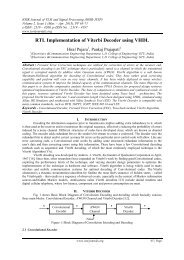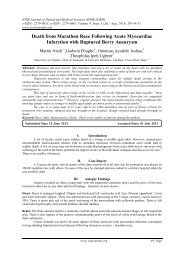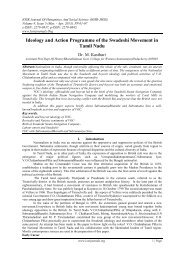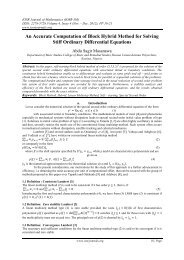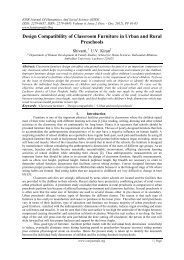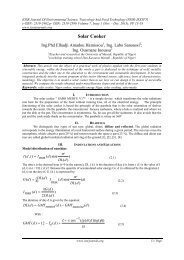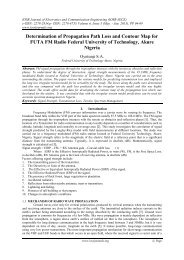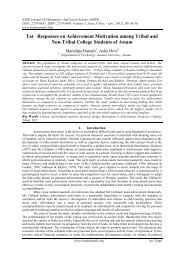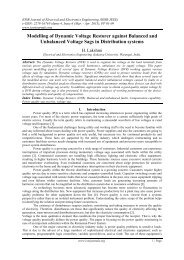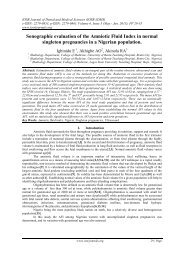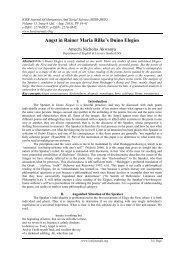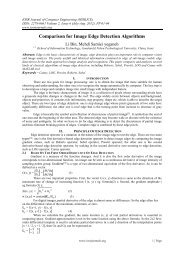Initial Conquest of India by Turks and Their Slaves - IOSR
Initial Conquest of India by Turks and Their Slaves - IOSR
Initial Conquest of India by Turks and Their Slaves - IOSR
You also want an ePaper? Increase the reach of your titles
YUMPU automatically turns print PDFs into web optimized ePapers that Google loves.
Influencing factors <strong>of</strong> Mental Health <strong>of</strong> Adolescents at School Level<br />
success (DuRent, Getts, Cadenhead, Emans, & Woods, 1995) 11 . Low-income parents may have less time <strong>and</strong><br />
fewer resources than higher socio-economic parents to supervise their children <strong>and</strong> to provide them with<br />
structured recreational <strong>and</strong> social activities (Garbarino, 1992) 12 . In these situations, peers may play a more active<br />
<strong>and</strong> determining role in influencing theacademic performance <strong>of</strong> adolescents.According to Collins, (2003) 8 ;<br />
Connolly & Goldberg, (1999) 9 ,peer relations may have mental health benefits, including the provision <strong>of</strong> social<br />
support, enhancement <strong>of</strong> self-esteem, preparation for adult relations, <strong>and</strong> the development <strong>of</strong> intimacy.<br />
The peer group is important for adolescent social <strong>and</strong> emotional development because youngsters<br />
derive a sense <strong>of</strong> belonging <strong>and</strong> acceptance from peers (La Greca & Prinstein, 1999) 20 . Longitudinal studies<br />
also have linked childhood peer rejection to symptoms <strong>of</strong> internalized distress in adolescence, suggesting a<br />
causal role for peer rejection (Coie, Lochman, Terry, & Hyman, 1992) 6 <strong>and</strong> Kupersmidt & Patterson, 1991) 19 .<br />
Prospective studies also indicate that symptoms <strong>of</strong> depression predict subsequent peer rejection. Vernberg<br />
(1990) 34 followed early adolescents over a school year, finding that depressive symptoms early in the year,<br />
predicted higher levels <strong>of</strong> peer rejection 6 months later. Similarly, Little <strong>and</strong> Garber (1995) 21 found that<br />
symptoms <strong>of</strong> depression among early adolescents predicted an increase in peer rejection over a 3-month period<br />
2.3 Studies on impact <strong>of</strong> School enviroment on Mental Health <strong>of</strong> Adolescents<br />
Ramanath Kundu <strong>and</strong> Jayanti Basu (1991) 18 indicated that academic achievement <strong>and</strong> neu roticism<br />
were related to each other <strong>and</strong> could be predicted from various modes <strong>of</strong> frustration reactions. Devi.S <strong>and</strong><br />
K.Mayuri (2003) 10 concluded that school factors like well qualified teachers, good curriculum <strong>and</strong> subject<br />
matter on time, impressive method <strong>of</strong> teaching <strong>and</strong> teacher-student interaction have contributed significantly<br />
with the academic achievement. Study <strong>of</strong> Suneetha, B. et.al (2001) 32 reveals that out <strong>of</strong> 9 factors observed,<br />
majority <strong>of</strong> them exhibited significant positive correlation with academic achievement. So it was concluded that<br />
school, the second most intimate environment next to home has fascinating effect on the child‟s high<br />
performance at school. Cairns <strong>and</strong> Lloyd (2005) 3 extracted that the school work <strong>and</strong> exams was the most cited<br />
cause <strong>of</strong> stress for young people <strong>of</strong> 16 years old. Anonymous (2004) 1 has examined trends between 1983 <strong>and</strong><br />
2003 in young people‟s emotional health <strong>and</strong> wellbeing, as reported through their young people <strong>and</strong> health<br />
survey <strong>and</strong> has found that young people are increasingly more likely to worry quite a lot about school <strong>and</strong> career<br />
problems.<br />
III. Methodology<br />
This section deals with the methodology adopted for the study. It includes the research approach,<br />
design for the study, the setting, sample <strong>and</strong> sampling technique, development <strong>of</strong> the tools, pilot study, data<br />
collection procedure <strong>and</strong> data analysis.<br />
3.1 Research approach<br />
Survey method has been adopted to study the primary aim <strong>of</strong> the researcher i.e to observe the influence<br />
<strong>of</strong> Parent-Child Relation (PCR), School Environment(SE) <strong>and</strong> Peer Relation(PR) on Mental Health(MH) <strong>of</strong><br />
adolescents at high school level <strong>and</strong> also to find the impact <strong>of</strong> demographic variables such as school, class <strong>and</strong><br />
sex on mental health <strong>of</strong> adolescents.<br />
3.2 Population<br />
The population for the present study consists <strong>of</strong> both boys <strong>and</strong> girls studying 8 th to 10 th classes from<br />
Government <strong>and</strong> Private schools in Chittoor district <strong>of</strong> Andhra Pradesh.<br />
3.3 Sample <strong>and</strong> Sampling Technique<br />
The survey was conducted at Government <strong>and</strong> Private high schools located at Chittoor district. Five<br />
Government Schools <strong>and</strong> Five Private Schools are selected at r<strong>and</strong>om <strong>and</strong> from each school 30 students in<br />
which 15 boys <strong>and</strong> 15 girls are selected. Further such a care has been taken <strong>by</strong> researcher that 5 boys <strong>and</strong> 5 girls<br />
must include from each <strong>of</strong> 8th, 9 th <strong>and</strong> 10 th classes so that the total students from Government <strong>and</strong> Private<br />
schools are 150 each. The sample distribution according to class <strong>and</strong> sex is exhibited in the following table.<br />
Sex <strong>and</strong> class distribution <strong>of</strong> the adolescents for the study<br />
School<br />
8 th class 9 th class 10 th class<br />
Boys Girls Boys Girls Boys Girls<br />
Total<br />
Government 25 25 25 25 25 25 150<br />
Private 25 25 25 25 25 25 150<br />
Total<br />
50 50 50 50 50 50<br />
100 100 100<br />
300<br />
www.iosrjournals.org<br />
51 | Page



